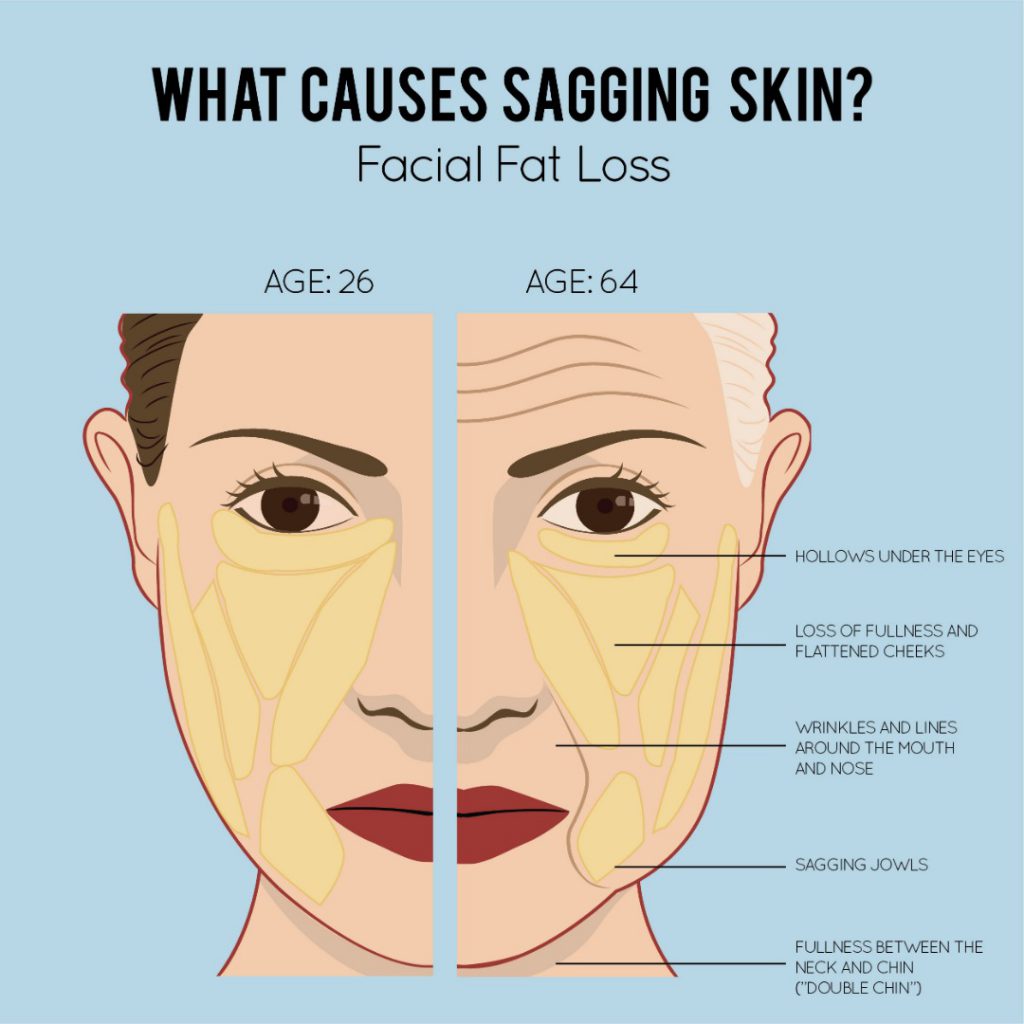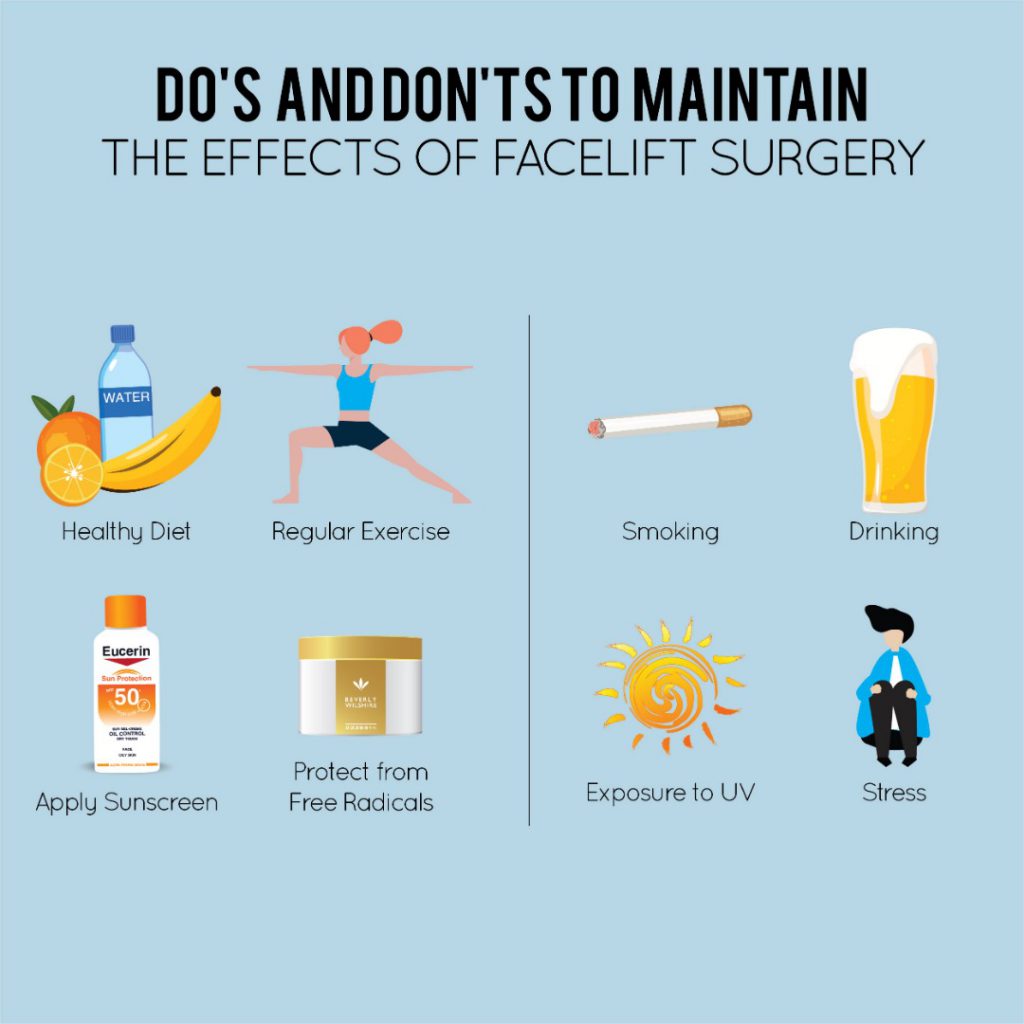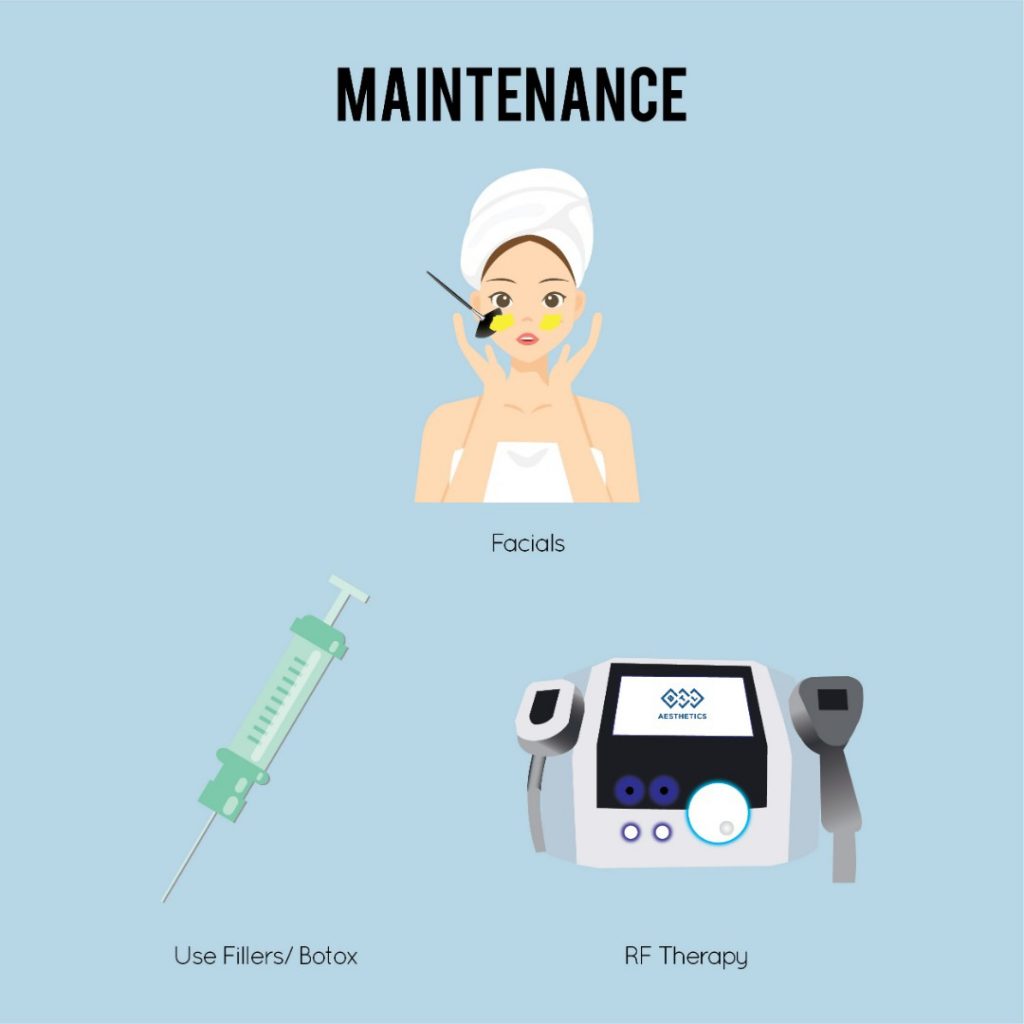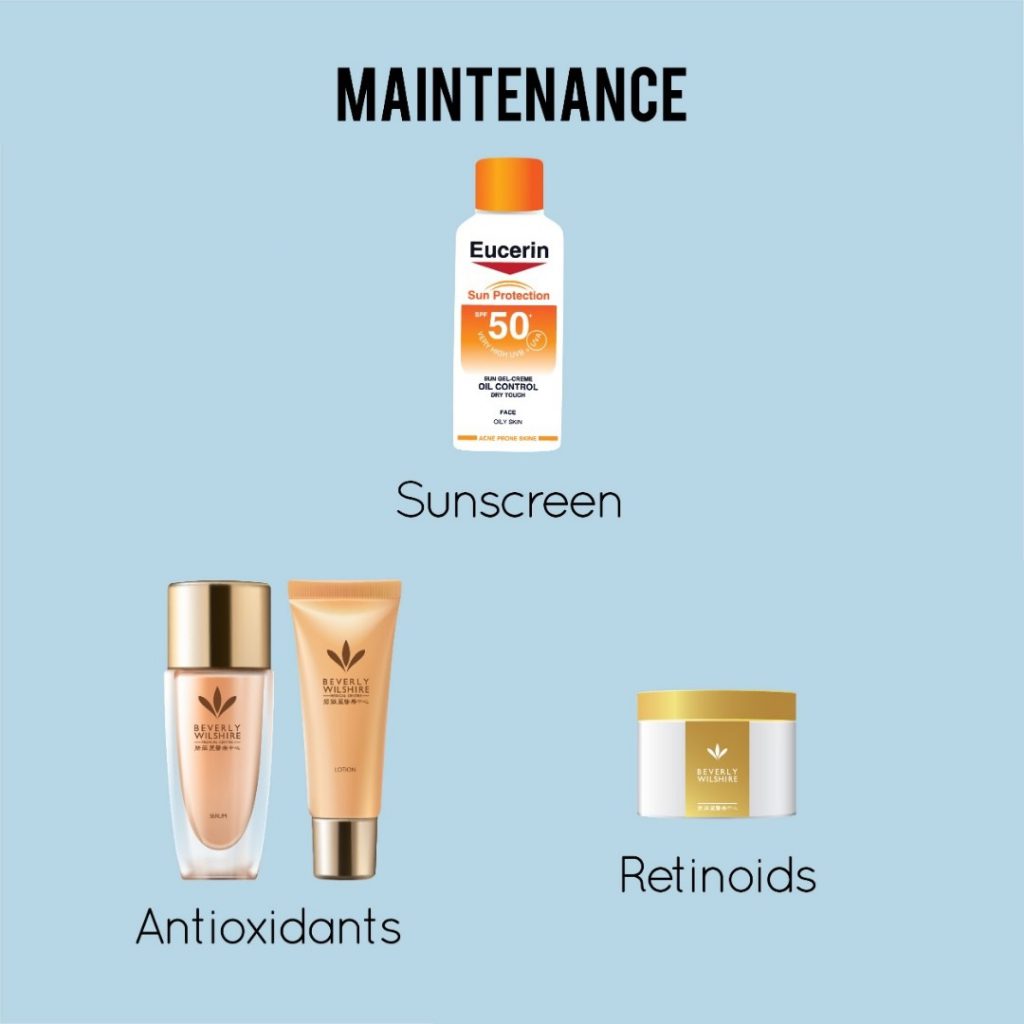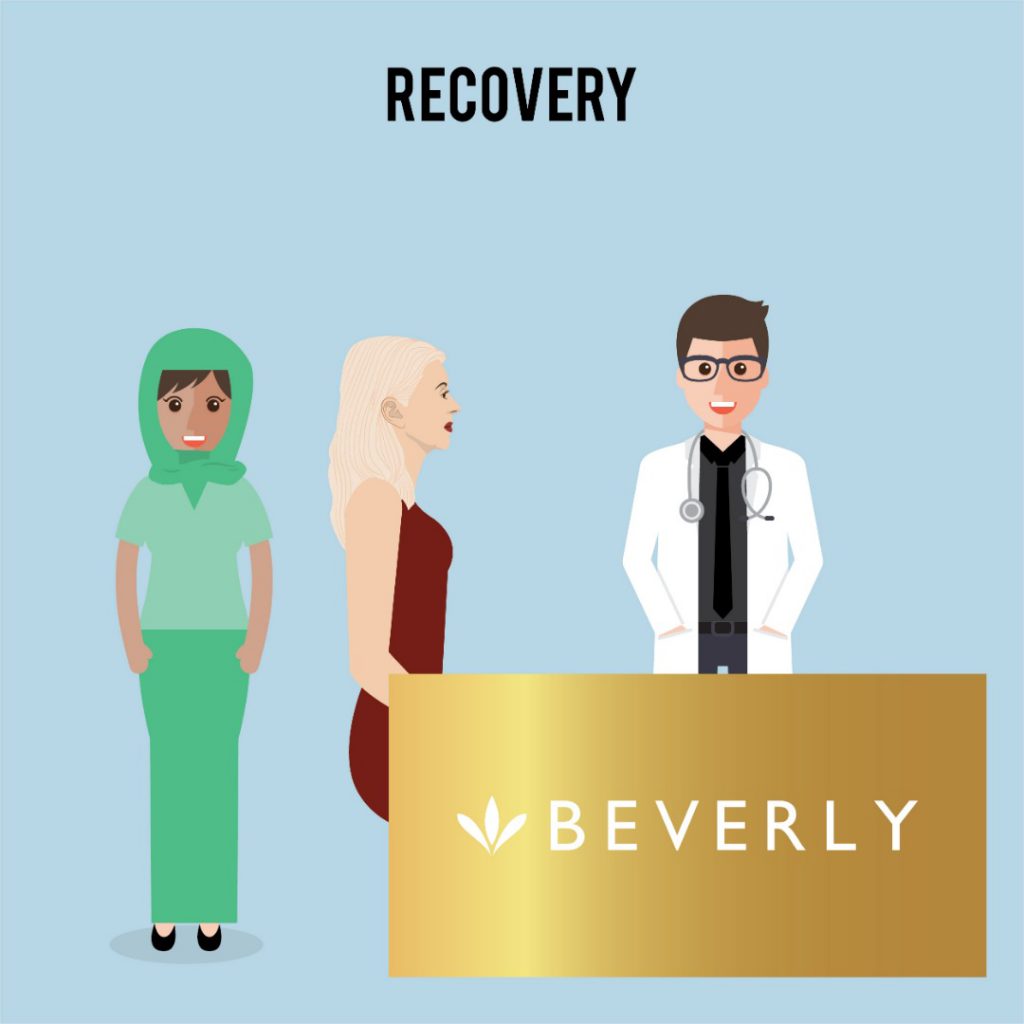Sagging skin is due to two reasons: loss of collagen, which gives the skin elasticity, and loss of facial fat, the absence of which causes the skin to droop.
Age is the most obvious answer. As we age, we’ll find that gravity does a number on us, your skin loses its elasticity, you will notice that it doesn’t bounce back as it used to when you were younger.
Being outdoors for long hours means higher exposure of UV, which over time breaks collagen down. To combat this, make sure you apply plenty of sunscreen before leaving your home. Whether you are indoors or outdoors, it is equally important to apply sunscreen.
Weight loss may also be a culprit to sagging skin. The idea is when you gain weight, the skin on your face stretches along with the extra padding, but when you finally lose it, you may notice eye bags and a slack jaw. To combat this, you may opt for aesthetic treatments (non-surgical) such as injectable fillers to give your face “additional volume”.
Aesthetic treatments cannot achieve the same results as cosmetic surgery but may help delay the aging process. At some point of time, a facelift (surgical) is necessary to address the dramatic signs of aging.
[/vc_column_text][vc_row_inner column_margin=”default” column_direction=”default” column_direction_tablet=”default” column_direction_phone=”default” text_align=”left”][vc_column_inner column_padding=”no-extra-padding” column_padding_tablet=”inherit” column_padding_phone=”inherit” column_padding_position=”all” background_color_opacity=”1″ background_hover_color_opacity=”1″ column_shadow=”none” column_border_radius=”none” column_link_target=”_self” gradient_direction=”left_to_right” overlay_strength=”0.3″ width=”1/3″ tablet_width_inherit=”default” column_border_width=”none” column_border_style=”solid” bg_image_animation=”none”][image_with_animation image_url=”25561″ animation=”Fade In” hover_animation=”none” alignment=”center” border_radius=”none” box_shadow=”none” image_loading=”default” max_width=”100%” max_width_mobile=”default”][/vc_column_inner][vc_column_inner column_padding=”no-extra-padding” column_padding_tablet=”inherit” column_padding_phone=”inherit” column_padding_position=”all” background_color_opacity=”1″ background_hover_color_opacity=”1″ column_shadow=”none” column_border_radius=”none” column_link_target=”_self” gradient_direction=”left_to_right” overlay_strength=”0.3″ width=”1/3″ tablet_width_inherit=”default” column_border_width=”none” column_border_style=”solid” bg_image_animation=”none”][image_with_animation image_url=”25559″ animation=”Fade In” hover_animation=”none” alignment=”center” border_radius=”none” box_shadow=”none” image_loading=”default” max_width=”100%” max_width_mobile=”default”][/vc_column_inner][vc_column_inner column_padding=”no-extra-padding” column_padding_tablet=”inherit” column_padding_phone=”inherit” column_padding_position=”all” background_color_opacity=”1″ background_hover_color_opacity=”1″ column_shadow=”none” column_border_radius=”none” column_link_target=”_self” gradient_direction=”left_to_right” overlay_strength=”0.3″ width=”1/3″ tablet_width_inherit=”default” column_border_width=”none” column_border_style=”solid” bg_image_animation=”none”][image_with_animation image_url=”25557″ animation=”Fade In” hover_animation=”none” alignment=”center” border_radius=”none” box_shadow=”none” image_loading=”default” max_width=”100%” max_width_mobile=”default”][/vc_column_inner][/vc_row_inner][vc_column_text]What is a facelift?
A Rhytidectomy, a.k.a. facelift to the rest of us is a procedure in cosmetic surgery that aims to give a more youthful appearance to the face. A facelift can tighten loose, hanging skin around the jowls (jawline). It can also remove deep creases around the mouth and nose, and any excess fat and skin under the chin and turkey neck. The procedure can be combined with a browlift to enhance the forehead, brows, and eyelids. In fact, it is commonly done together, an overall facelift is one of the most popular procedures in the center.
There are many different types of facelift procedures that exist. The differences are mostly in the type of incision, the invasiveness and the area of the face that is treated. Every surgeon has their preference and some practice using multiple different types of facelift surgery. It is best to consult with your surgeon on your expected outcome and which procedure is best for your needs. There are other factors that need to be considered such as patient expectation, age, recovery time, etc.
What is the facelift surgery process like?
If the patient is on medication, such as blood thinners or aspirin, he or she has to stop as it will cause bruising. However, if the patient is a diabetic or has hypertension, he or she may continue with the medication. Our plastic surgeon will provide pre-operation instructions, please ensure you follow the guidelines or you may not be able to proceed with the facelift surgery.[/vc_column_text][vc_row_inner column_margin=”default” column_direction=”default” column_direction_tablet=”default” column_direction_phone=”default” text_align=”left”][vc_column_inner column_padding=”no-extra-padding” column_padding_tablet=”inherit” column_padding_phone=”inherit” column_padding_position=”all” background_color_opacity=”1″ background_hover_color_opacity=”1″ column_shadow=”none” column_border_radius=”none” column_link_target=”_self” gradient_direction=”left_to_right” overlay_strength=”0.3″ width=”1/2″ tablet_width_inherit=”default” column_border_width=”none” column_border_style=”solid” bg_image_animation=”none”][image_with_animation image_url=”25555″ animation=”Fade In” hover_animation=”none” alignment=”center” border_radius=”none” box_shadow=”none” image_loading=”default” max_width=”100%” max_width_mobile=”default”][/vc_column_inner][vc_column_inner column_padding=”no-extra-padding” column_padding_tablet=”inherit” column_padding_phone=”inherit” column_padding_position=”all” background_color_opacity=”1″ background_hover_color_opacity=”1″ column_shadow=”none” column_border_radius=”none” column_link_target=”_self” gradient_direction=”left_to_right” overlay_strength=”0.3″ width=”1/2″ tablet_width_inherit=”default” column_border_width=”none” column_border_style=”solid” bg_image_animation=”none”][image_with_animation image_url=”25553″ animation=”Fade In” hover_animation=”none” alignment=”center” border_radius=”none” box_shadow=”none” image_loading=”default” max_width=”100%” max_width_mobile=”default”][/vc_column_inner][/vc_row_inner][vc_column_text]Before Facelift Surgery
Firstly, the nurses will prepare the patient. When the patient is in a sitting position, the surgeon will start with marking. In the marking process, it is not just an indicator where the surgeon will make an incision, but also the angle in which it will be inserted. Marking can’t be done when the patient is laying down, as there will be muscle moment when the patient is lying flat, this is why surgeons get the marking done before the surgery. It is a very crucial process to ensure the success of the surgery.
After the surgeon has done the initial marking process, the anesthetist will see the patient and assess them, they will be injected with general anesthesia which will knock the patient out for a short time. The nurses will then check on the general well-being of the patient such as blood pressure, pulse, temperature, etc. Once the nurses have completed, the doctor can begin the surgery.
During Facelift Surgery
The facelift is quite a long procedure, it takes roughly 4 hours, this is the reason why surgeons prefer to use general anesthesia. It will be more comfortable for the patient to be under general anesthesia rather than local anesthesia, as patients will not hold still under local anesthesia for 4 hours.
The surgeon will give antibiotics and anti-clogging medicine through IV during the surgery, small doses of steroids will help to reduce swelling.
Traditionally, the surgeons will make an incision in front of the ear, extending up into the hair/hairline as well as behind the ear into the hair-bearing scalp.
The surgeon then lifts the skin off the deeper facial muscles and fat, gently pulls the skin in an upward direction and removes any excess skin. They may also tighten the deeper tissues of the face.
If the patient is getting an additional neck lift, a small incision will be made under the chin to tighten the skin.
The next step for the surgeon is to close the incisions with sutures. A drain may be placed under the skin behind the eat for one or two days, to remove any excess blood or fluids. Bandages are then applied.
After Surgery & Recovery
Once the surgery is completed, the patient will be placed under observation for 1 – 2 days in the ward.
First Day After Surgery: There will be bandage around your face.
Second Day After Surgery: Patient is allowed to shower, it is safe for the wounds to get wet. If there are no complications, the patient can be discharged. If patients are concerned about how they look after the surgery, they can opt to keep their hair down and wear dark sunglasses.
Day 5 to 10 After Surgery: Sutures will be removed. At this point, the patient must follow the specific instructions given by the team for bathing and washing. It’s important to follow these instructions, as it will speed the healing process and allow for the best possible results.
Generally, a facelift is not a painful procedure, however, there may be slight discomfort because of the swelling from the surgery. If there is a lot of swelling, it could be an indicator of bleeding or a blood clot. If the swelling becomes too large, it will need to be drained. It is uncommon during facelift surgery; however, it can happen sometimes.
After the surgery, the swelling will dissipate around 2 weeks. Kindly refrain from vigorous activities and weight lifting. You may resume light exercises after 4 weeks. Patients are advised to come for regular check-ups until the swelling comes down. There will be medications given to the patient; such as antibiotics to relieve tenderness.
Scarring may take place and can take up to a year for it to fade, however, if this is a strong concern of yours do talk to our doctors, as Beverly offers aesthetic procedures in tackling scarring.
Do take note that the result of a facelift does not last forever, is said to last around 10 years.
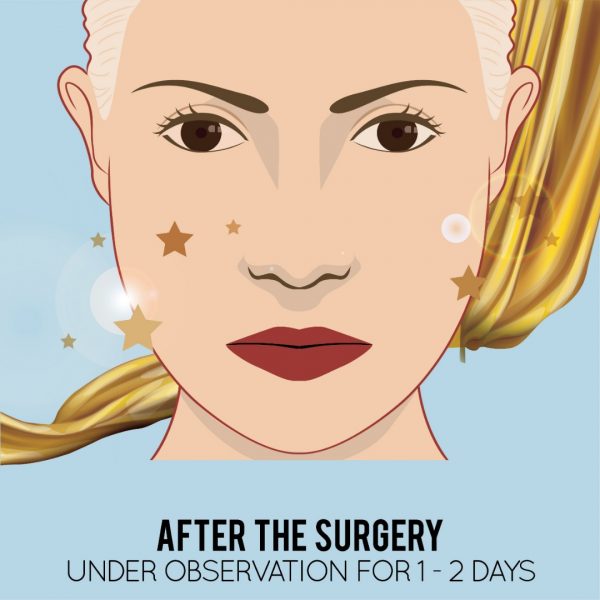
Maintenance
As part of maintenance after the facelift surgery, there are several things you can do:
- Healthy lifestyle: Balanced diet and sufficient exercise will help to maintain supple skin.
- Avoid smoking, alcohol, stress if possible, otherwise consider minimizing them.
- Try liquid gold, a.k.a. injectables such as Fillers and Botox.
- Using RF therapy such as Exilis and Thermage can also assist in stimulating collagen reproduction.
- We’ve often heard how damaging the sun is, it really is the skin’s worst enemy. Long-term exposure causes the collagen to break down and elastin to deteriorate. Avoid sun exposure and contact with pollutants, these can all add up to help extend your youthful appearance. It’s vital to choose broad spectrum sunscreens that effectively cover UVA/UVB, which offers longer-lasting protection. It’s best to use at least SPF50 in our hot Malaysian weather.
- Using a cream or serum containing retinoids (creams with Vitamin A) each day will help to re-stimulate production of collagen.
- Protect your face against free radicals (a.k.a environmental factors), choose products containing antioxidants such as Vitamin C.

